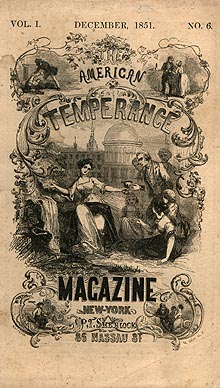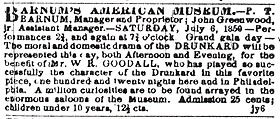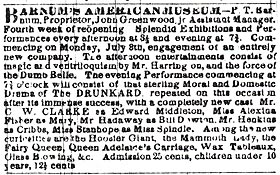
American Temperance Magazine
December 1851 Cover
|
The Drunkard was probably America's most successful play before Uncle Tom's Cabin. As the Preface below
explains, it was the creation of two writers. The unnamed literary "gentleman" who wrote the "story in dialogue" was, scholars agree,
most likely John Pierpont, a Unitarian minister and prominent Boston reformer. (The stigma of disrepute that attached to
the theatre in Victorian America would be one reason Rev. Pierpont would wish to be anonymous.) Mainly the script was the work of William
H. Smith, stage manager at the Boston Museum and star of the play during its original run there; for the theatrical business Smith
drew on his experience with the conventions of melodrama, and for the part of Edward Middleton, especially his encounter
with delerium tremens at the start of Act 4, he drew on his experience as an alcoholic who had signed the Washingtonians'
pledge.
Smith's play was almost the first of the more than 100 American temperance plays listed by Hixon and
Hennessey,* and
the most popular until 1858, when the dramatization of
T. S. Arthur's Ten Nights in a Bar-Room took that title. The Boston Museum
production played over 140 times during the 1844-1845 season, a performance record that lasted till the
Howards brought Aiken's Uncle Tom to New York's National in 1853. P. T. Barnum used The Drunkard to inaugurate
his stage at the American Museum when it opened in 1850. (The text available here is the one used at Barnum's, with its very
topical references to Broadway and the Five Points neighborhood, and specific New York buildings like "The Arbor" and even "Barnum's
Museum"; when the show opened in Boston the references were to Dock Square and "a well-known bar room on School
Street."*)
|
This was also the play the Howards were staging in Troy, New York, with
their 4-year-old daughter Cordelia in the role of Julia, when they decided to ask George Aiken to write another play to take advantage of
Cordelia's natural talents. From Julia, then, Cordelia stepped into the role of Eva St. Clare.That is only one of the many interconnections between the two works, Smith's and Stowe's. While Uncle Tom's Cabin is
overtly anti-drinking, slavery is not mentioned in The Drunkard. Both works, however, dramatize a social evil and
entertain 19th century audiences in many similar ways.
|



